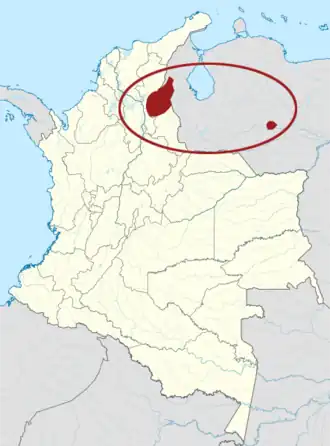Barí language
| Barí | |
|---|---|
| Barira, Cunausaya, Dobocubi, Motilón, Motilone | |
| Barí ara | |
| Native to | Colombia, Venezuela |
| Region | Norte de Santander Department, Serranía de los Motilones, Upper Catatumbo and Oro River region, Reserva Indígena Motilón-Barí and Resguardo Indígena Gabarra-Catalaura; also in Cesar Department, Chimichagua, La Gloria, and Pailitas municipalities |
| Ethnicity | Motilon people |
Native speakers | 5,000 (2007–2008)[1] |
Chibchan
| |
| Language codes | |
| ISO 639-3 | mot |
| Glottolog | bari1297 |
| ELP | Barí |
 | |
Barí is a Chibchan language spoken in Northwestern South America by the Barí (Motilon).
Phonology
Barí has six vowels: /i, e, a, ɨ, o, u/. All vowels have nasalized forms as /ĩ, ẽ, ã, ɨ̃, õ, ũ/.[2]
| Bilabial | Alveolar | Palatal | Velar | Glottal | ||
|---|---|---|---|---|---|---|
| Plosive | voiceless | t | k | |||
| voiced | b | d | ||||
| Fricative | s | h | ||||
| Nasal | m | n | ɲ | |||
| Trill | r | |||||
Vocabulary
| Barí | Spanish | English |
| intok | uno | one |
| insami | dos | two |
| tẽtahko | tres | three |
| dary | hombre | man |
| biory | mujer | woman |
| ruraba | perro | dog |
| ña | sol | sun |
| chibai | luna | moon |
| xima | agua | water |
| ixtan | tierra | earth |
| bowara | montaña | mountain |
| kona | rocío | dew |
References
- ^ Barí at Ethnologue (18th ed., 2015) (subscription required)
- ^ Mogollón-Pérez, María Cristina (2000). Fonología de la lengua barí. In González de Pérez, María Stella and Rodríguez de Montes, María Luisa (eds.), Lenguas indígenas de Colombia: una visión descriptiva: Santafé de Bogotá: Instituto Caro y Cuervo. pp. 719–727.
{{cite book}}: CS1 maint: publisher location (link)
- Bruce Olson. Bruchko. Charisma House, 1977.